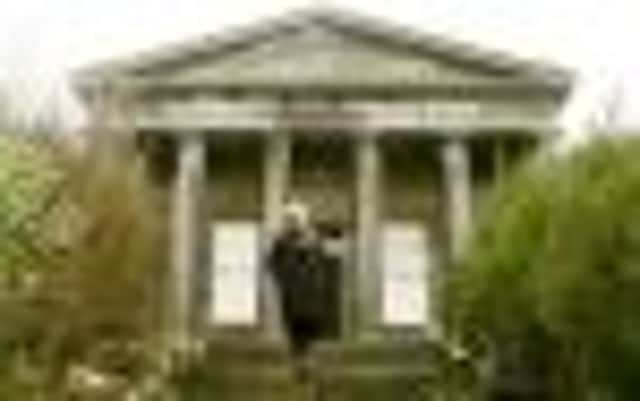Art review: Edinburgh’s Art Collective


As Kate Gray, director of Edinburgh’s Collective, describes her vision for the gallery’s new home in the City Observatory, the stunning William Henry Playfair building atop Calton Hill, I can’t help being distracted by the view.
As I scan the horizon from the snow-dusted Pentlands to the mist-shrouded Forth, with a whole chunk of Scottish history in between, Gray describes the way that past and present come together: “There’s a palpable sense of excitement, you can still feel it in the site itself.”
Advertisement
Hide AdThis month more than 60 contemporary artists are backing Gray’s vision to turn the site into two world-class spaces, one hosting an international programme, the other housing the New Work Scotland Programme, which supports younger artists in their early careers.
They are donating work for a fund-raising auction, which will open online on 14 February and culminate on 14 March in a celebration and live auction at Lyon and Turnbull in central Edinburgh. Among them are Callum Innes, Turner Prize winners Martin Boyce and Jeremy Deller, overseas figures like Spencer Finch, and a veritable who’s who of the Scottish art world. All of them have exhibited at the gallery since it was founded as an artist-led collective in 1984.
Graham Fagen, for example, has worked with some of the country’s most important institutions. The Scottish National Portrait Gallery and the National Theatre of Scotland commissioned his recent film, Missing. He has shown at the V&A and the Imperial War Museum. But back in 1990 he was an inexperienced young graduate still finding his feet when he was invited to show at the gallery. “I guess I had my very first public exhibition with Collective in the early 1990s,” he tells me, “when the gallery was in the High Street.” He has donated a drawing inspired by Robert Burns, The Liberty Tree, “so that other duffers like myself might get the same opportunities.”
Similarly, when I speak to Moyna Flannigan, who has donated a painting, she has just completed a new body of work for a forthcoming show at her Amsterdam gallery. These days you’ll find her paintings in the collection of the Scottish National Gallery of Modern Art, but Collective offered her one of her first public opportunities. “Collective was an important platform for the public and your peers to show your work in an atmosphere that was supportive.” She went on to join the Members’ Committee and, when the gallery changed its structure, she sat on its board.
For Flannigan, one of the attractions of the proposal is the nature of the site, a group of small, functional buildings, dressed up as a classical temple and in a spectacular setting. “It’s a move away from the conventional white cube gallery that has become the norm. It may generate new ideas, the space has such a lot of history.”
As Gray takes me round, the complexities become apparent. The City Observatory, built in 1818, has not been consistently used for around a decade. It once housed three telescopes, two on its ground floor and one in its domed roof. Its interior spaces are complex and in need of attention. More recent history is also present: a dusty panelled office; a cupboard door lined with cartoons about astronomy.
Advertisement
Hide AdImportant instruments, such as the politician’s clock (it was two-faced), are being refurbished at the National Museums of Scotland. But the building still houses instruments which must be preserved and kept accessible. Gray shows me the Transit Telescope, which would be preserved under her plans, the closed shutters reopened and glazed to open the building to light.
The Transit Telescope was used to calculate time: this was very much a place about scientific optimism and the here and now. “This place produced time for the city,” she explains. “Residents could set their time pieces and mariners came from the Port of Leith with their chronometers.”
Advertisement
Hide AdThe Observatory is held in the Common Good for the city. The gallery takes its responsibilities seriously. Plans are at their early stages and change will be incremental as fundraising allows. From June, Gray and her team will be housed on the hard standing on the top of the hill, in a temporary building outside the Observatory walls. Soon they will begin to show work in the City Dome where refurbishment has already begun.
It is a vast and atmospheric empty building built in 1896 that became obsolete when the Observatory moved its functions to a new site in Blackford. The site has been master-planned by Malcolm Fraser Architects and the team is working closely with Edinburgh City Council, Historic Scotland and Creative Scotland.
The building is one of William Henry Playfair’s earliest commissions. The design is based on a Greek Temple of the Four Winds, with a walled garden. “But we’re not going to come up here and hide behind the walls,” says Gray. The building is a ten-minute walk from Waverley and the hill itself is a surprisingly busy destination.
It was, she confesses, “almost naivety that brought me here” when her current premises in Cockburn Street were sold. “People are so supportive and just want the buildings to find a use.”
We look around the site, which despite its grandeur is looking windswept and in clear need of occupation. “It can’t just be about conservation with a small c. It has to be about vision.” And Gray’s vision to revitalise this place, “to bring contemporary art into the iconic heart of Edinburgh”, is beginning to become a reality.
Twitter: @moirajeffrey
For more information about the redevelopment and the fundraising auction see www.collectivegallery.net